The nucleoporin Mlp2 is involved in chromosomal distribution during mitosis in trypanosomatids
- PMID: 25690889
- PMCID: PMC4417144
- DOI: 10.1093/nar/gkv056
The nucleoporin Mlp2 is involved in chromosomal distribution during mitosis in trypanosomatids
Abstract
Nucleoporins are evolutionary conserved proteins mainly involved in the constitution of the nuclear pores and trafficking between the nucleus and cytoplasm, but are also increasingly viewed as main actors in chromatin dynamics and intra-nuclear mitotic events. Here, we determined the cellular localization of the nucleoporin Mlp2 in the 'divergent' eukaryotes Leishmania major and Trypanosoma brucei. In both protozoa, Mlp2 displayed an atypical localization for a nucleoporin, essentially intranuclear, and preferentially in the periphery of the nucleolus during interphase; moreover, it relocated at the mitotic spindle poles during mitosis. In T. brucei, where most centromeres have been identified, TbMlp2 was found adjacent to the centromeric sequences, as well as to a recently described unconventional kinetochore protein, in the periphery of the nucleolus, during interphase and from the end of anaphase onwards. TbMlp2 and the centromeres/kinetochores exhibited a differential migration towards the poles during mitosis. RNAi knockdown of TbMlp2 disrupted the mitotic distribution of chromosomes, leading to a surprisingly well-tolerated aneuploidy. In addition, diploidy was restored in a complementation assay where LmMlp2, the orthologue of TbMlp2 in Leishmania, was expressed in TbMlp2-RNAi-knockdown parasites. Taken together, our results demonstrate that Mlp2 is involved in the distribution of chromosomes during mitosis in trypanosomatids.
© The Author(s) 2015. Published by Oxford University Press on behalf of Nucleic Acids Research.
Figures
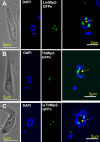
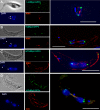


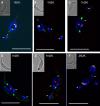
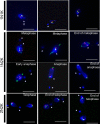

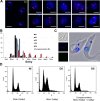
Similar articles
-
Identification of the centromeres of Leishmania major: revealing the hidden pieces.EMBO Rep. 2017 Nov;18(11):1968-1977. doi: 10.15252/embr.201744216. Epub 2017 Sep 21. EMBO Rep. 2017. PMID: 28935715 Free PMC article.
-
Microtubule-severing proteins are involved in flagellar length control and mitosis in Trypanosomatids.Mol Microbiol. 2009 Mar;71(6):1353-70. doi: 10.1111/j.1365-2958.2009.06594.x. Epub 2009 Jan 16. Mol Microbiol. 2009. PMID: 19183280
-
Inhibition of active nuclear transport is an intrinsic trigger of programmed cell death in trypanosomatids.Cell Death Differ. 2008 Dec;15(12):1910-20. doi: 10.1038/cdd.2008.132. Epub 2008 Sep 12. Cell Death Differ. 2008. PMID: 19011643
-
Nucleoporins: leaving the nuclear pore complex for a successful mitosis.Cell Signal. 2011 Oct;23(10):1555-62. doi: 10.1016/j.cellsig.2011.05.023. Epub 2011 Jun 13. Cell Signal. 2011. PMID: 21683138 Review.
-
Centromeric chromatin and its dynamics in plants.Plant J. 2015 Jul;83(1):4-17. doi: 10.1111/tpj.12875. Plant J. 2015. PMID: 25976696 Review.
Cited by
-
Complex Commingling: Nucleoporins and the Spindle Assembly Checkpoint.Cells. 2015 Nov 3;4(4):706-25. doi: 10.3390/cells4040706. Cells. 2015. PMID: 26540075 Free PMC article. Review.
-
Proteomic Analysis of the Cell Cycle of Procylic Form Trypanosoma brucei.Mol Cell Proteomics. 2018 Jun;17(6):1184-1195. doi: 10.1074/mcp.RA118.000650. Epub 2018 Mar 19. Mol Cell Proteomics. 2018. PMID: 29555687 Free PMC article.
-
Trafficking and/or division: Distinct roles of nucleoporins based on their location within the nuclear pore complex.RNA Biol. 2022;19(1):650-661. doi: 10.1080/15476286.2022.2067711. Epub 2021 Dec 31. RNA Biol. 2022. PMID: 35491934 Free PMC article.
-
NuSAP4 regulates chromosome segregation in Trypanosoma brucei by promoting bipolar spindle assembly.Commun Biol. 2024 Nov 16;7(1):1524. doi: 10.1038/s42003-024-07248-5. Commun Biol. 2024. PMID: 39550521 Free PMC article.
-
Genome-wide subcellular protein map for the flagellate parasite Trypanosoma brucei.Nat Microbiol. 2023 Mar;8(3):533-547. doi: 10.1038/s41564-022-01295-6. Epub 2023 Feb 20. Nat Microbiol. 2023. PMID: 36804636 Free PMC article.
References
-
- Davis L.I. The nuclear pore complex. Annu. Rev. Biochem. 1995;64:865–896. - PubMed
-
- Pante N., Aebi U. Molecular dissection of the nuclear pore complex. Crit. Rev. Biochem. Mol. Biol. 1996;31:153–199. - PubMed
-
- Gorlich D., Mattaj I.W. Nucleocytoplasmic transport. Science. 1996;271:1513–1518. - PubMed
-
- Nigg E.A. Nucleocytoplasmic transport: signals, mechanisms and regulation. Nature. 1997;386:779–787. - PubMed
Publication types
MeSH terms
Substances
LinkOut - more resources
Full Text Sources
Other Literature Sources

